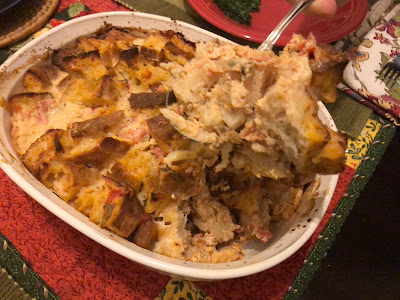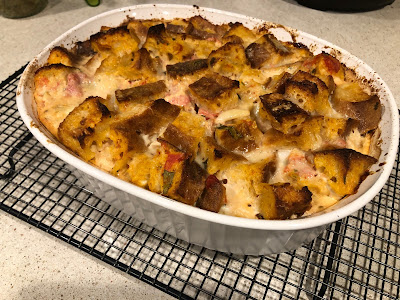
Recipe: Tomatoes add color to savory bread pudding

The skins slip right off after garlic cloves are boiled in broth, which mellows the garlic's bite. (Photos: Kathy Morrison)
|
A gardener's dilemma is often solved in the kitchen.
The most recent problem I encountered was what to do with the many small cloves left over from planting my garlic. Gardeners are advised to plant only the biggest cloves, and to keep the skin on them to protect the cloves while they're growing.
But when I broke up the heads from my seed garlic (late California variety), there were so many small cloves! I did have enough big ones to plant, but I was going to have to cook the little ones soon or risk them drying out. (For the record, you also can plant the small cloves to grow garlic scapes.)
I decided to unearth a cooking trick I learned years ago: Boiling the garlic cloves in broth or water. The boiling mellows the garlic's pungency. The boiled garlic is solid, not buttery, as when whole heads are roasted.
Some home-canned yellow tomatoes, some red ones from the freezer and half a loaf of stale ciabatta bread became the rest of the base for a garlic-infused bread pudding that is a terrific casserole or side dish for a fall dinner.

|
Tomato-garlic bread pudding
Serves 6
Ingredients:
1 to 2 cups chicken or vegetable broth
20 or so smallish garlic cloves, separated from the head
6 eggs, room temperature
1 cup milk or half and half
4 cups (2 pints) peeled tomatoes, with juice if canned, cut into chunks if they're whole
Salt and pepper
Seasonings: 1 tablespoon no-salt Italian seasoning, 1 tablespoon chopped parsley (or 1 teaspoon dried),
and handful of fresh basil leaves (sliced or chopped), or any variation of this as desired
8 cups of cubes from stale bread
Grated Parmesan cheese, for sprinkling
Instructions:
Heat oven to 375 degrees F. Grease a 2-1/2 quart baking dish with oil spray or butter.
Pour the broth into a small saucepan and bring to a boil. Trim the small stem end from the garlic cloves, then add the cloves to the boiling broth. Simmer on medium heat for 10 minutes or until the tip of a knife easily goes into one of the larger cloves. Don't dump the broth when straining: Lift the cloves out with a slotted spoon and put them on a cutting board.
Slip the skins off the cloves (they may be off already) and set aside for now. (The larger cloves can be cut in half if desired.)
In a large bowl, whisk together the eggs and milk. Add the tomatoes, salt and pepper to taste, the seasonings, and the garlic cloves. Add the bread cubes and stir thoroughly. At this point you can let the cubes soak up the liquid for a bit, if the bread is very stale, or continue to baking.
If the mixture still seems a bit dry to you, add some of the broth reserved from boiling the garlic.

|
When ready to bake, pour the bread mixture into the prepared pan.
Bake uncovered for 20 minutes. Sprinkle the Parmesan over the top, and cover the dish with the lid or a large piece of foil that has been sprayed with oil on one side (to keep the cheese from sticking to the foil).
Bake covered for an additional 20 minutes. Check for doneness — the liquid should be mostly absorbed and the pudding will be puffy. Add more cheese if desired. Bake for 5 to 10 minutes more uncovered. The pudding will be bubbling on the edges and the top will be golden and crispy. A knife inserted in center should come out clean.
Serve pudding warm or room temperature. Leftovers reheat well.
Comments
0 comments have been posted.Sacramento Digs Gardening to your inbox.
Sites We Like
Garden Checklist for week of April 21
This week there’s plenty to keep gardeners busy. With no rain in the immediate forecast, remember to irrigate any new transplants.
* Weed, weed, weed! Get them before they flower and go to seed.
* April is the last chance to plant citrus trees such as dwarf orange, lemon and kumquat. These trees also look good in landscaping and provide fresh fruit in winter.
* Smell orange blossoms? Feed citrus trees with a low dose of balanced fertilizer (such as 10-10-10) during bloom to help set fruit. Keep an eye out for ants.
* Apply slow-release fertilizer to the lawn.
* Thoroughly clean debris from the bottom of outdoor ponds or fountains.
* Spring brings a flush of rapid growth, and that means your garden is really hungry. Feed shrubs and trees with a slow-release fertilizer. Or mulch with a 1-inch layer of compost.
* Azaleas and camellias looking a little yellow? If leaves are turning yellow between the veins, give them a boost with chelated iron.
* Trim dead flowers but not leaves from spring-flowering bulbs such as daffodils and tulips. Those leaves gather energy to create next year's flowers. Also, give the bulbs a fertilizer boost after bloom.
* Pinch chrysanthemums back to 12 inches for fall flowers. Cut old stems to the ground.
* Mulch around plants to conserve moisture and control weeds.
* From seed, plant beans, beets, cantaloupes, carrots, corn, cucumbers, melons, radishes and squash.
* Plant onion sets.
* In the flower garden, plant seeds for asters, cosmos, celosia, marigolds, salvia, sunflowers and zinnias.
* Transplant petunias, zinnias, geraniums and other summer bloomers.
* Plant perennials and dahlia tubers for summer bloom.
* Mid to late April is about the last chance to plant summer bulbs, such as gladiolus and tuberous begonias.
* Transplant lettuce seedlings. Choose varieties that mature quickly such as loose leaf.